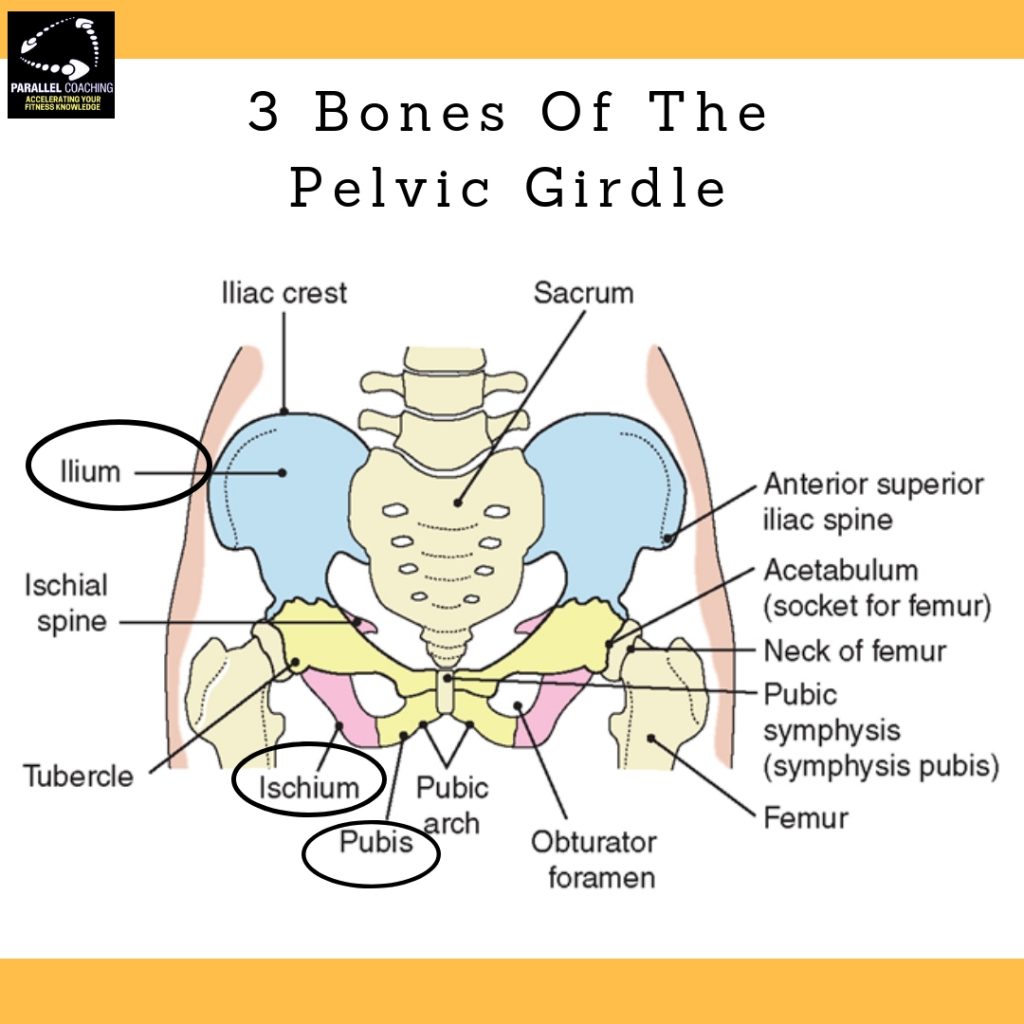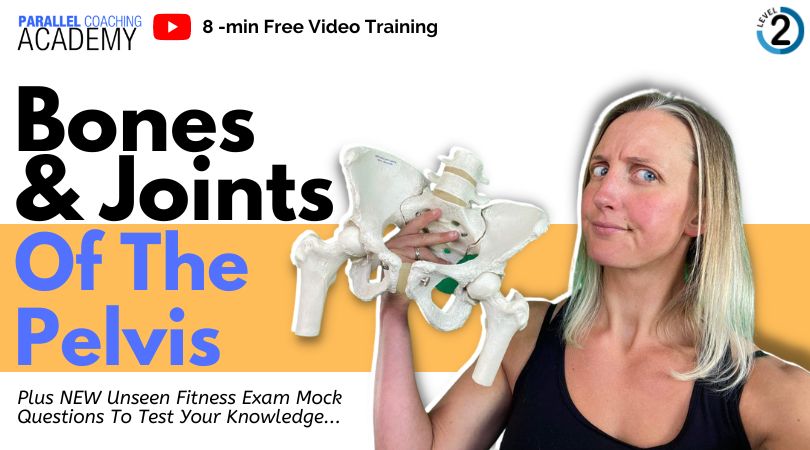Today’s blog explains (and shows you) the Bones and Joints of The Pelvis. You’ll see all three bones of the pelvis in a 3D view, and you’ll learn where the main joints of the pelvis are and how they operate.
You need to know this as part of the Level 2 and Level 3 Anatomy and Physiology exams, and this video and blog will set you up for success so you can pass this topic with confidence
First, watch the video and read the simplified notes before testing your knowledge with three mock questions.
Watch: Bones and Joints of The Pelvis
The Pelvis location and function
The Pelvis is a basin-shaped structure between the spine and the legs. It is often misunderstood, and people believe it to be part of the spine, getting it mixed up with the coccyx and sacrum.
However, the pelvis is not a fused central piece, it has two halves.
The right side has three bones, and the left side has three bones
This means that the pelvis is part of the Appendicular Skeleton.
>> Learn more about the Axial Appendicular Skeleton HERE
The Bones and Joints of The Pelvis are strong and stable, the main functions are:
- Transfer of weight from the upper axial skeleton to the lower appendicular components of the skeleton, especially during movements like walking and running.
- Provides attachment for a number of muscles and ligaments used in locomotion.
- Contains and protects vital digestive and reproductive organs.
The bones of the Pelvis
There are three Bones that make up EACH SIDE of the Pelvis:
The Ilium
The Right and left ilium are large fan-shaped bones, that give the pelvis its distinctive shape. These bones offer loads of surface area for muscle attachments. There are a few notable bony-land marks on the Ilium that you need to know for your Level 3 Anatomy and Physiology Exam:
- The Iliac Crest
- The Anterior Superior Iliac Spine (ASIS)
- The Posterior Superior Iliac Spine (PSIS)
The Pubis
The left and right pubic bones are the most anterior (front) of the pelvic bones. They make up the front section of the pelvis.
The Ischium
These are commonly known as your “Sits Bones” – you can feel these when you sit upright on a hard seat. These join with the Pubis to create the Obturator Foramen (looks like a hole from the front).

The Joints of the Pelvis
There are three main joints that make up EACH SIDE of the Pelvis:
Acetabulum
This is the ball and socket joint of the hip, whereby the head of the femur (upper leg bone) meets the pelvis. It is a deep and stable socket, however, it is also very mobile. The hip joint can create lots of joint actions, including hip flexion, hip extension, internal rotation, external rotation, abduction, adduction, and circumduction.
Pubic synthesis
The left and right pubic bones meet at the front of the pelvis joined by a cartilaginous joint called the pubic synthesis (this separates slightly at childbirth).
Sacroilliac Joint
This is the point where the spine and the pelvis meet. The sacrum is a large fused section of the lower spine and meets the ilium bones of the pelvis. This joint is therefore called Sacroiliac (meaning sacrum and ilium). This joint is made up of cartilage and ligament which allows some movement whilst being very stable. At the bottom of the joint there is a small synovial joint too.
A sacroiliac joint is often a place of pain and discomfort due to mal-alignment, uneven forces, running and repetitive hip movements.
Now you’ve watched the video and read the blog you’ll have a great understanding of the Bones and Joints of The Pelvis
Test Your Knowledge
1.What type of joint is the Pubic Synthesis?
A. Synovial
B. Cartilaginous
C. Fused
D. Fixed
2. Which of the following is not a bone of the pelvis?
A. Pubis
B. Femur
C. Ischium
D. Ilium
3. Which joint of the pelvis is the most mobile?
A. Acetabulum
B. Sternoclavicular
C. Sacroiliac
D. Pubic Synthesis
Answers:
1 = B
2 = B
3 = A
If you want more mock questions like this, then you can download more Free Mock Questions: DOWNLOAD NOW
Need More Help with your Level 3 Anatomy Revision?
For Trainee FITPROS Taking Their L3 Anatomy & Physiology Exam.
Learn, Revise & Pass Your Level 3 Anatomy & Physiology Exam In Under 10-hours
(Without Having To Spend Hours Revising Or Feeling Overwhelmed)
If you want to get your revision structured, learn everything you need to know, and feel confident on exam day, then click the link below:

Dedicated to More
Hayley “Bones and Joints of The Pelvis” Bergman
Parallel Coaching
P.S. You can also find us on the following platforms:
Instagram: Follow Now
Facebook: Like Our Page
Twitter: Tweet Us
YouTube: Subscribe Here
More Skeletal System Blogs: HERE

